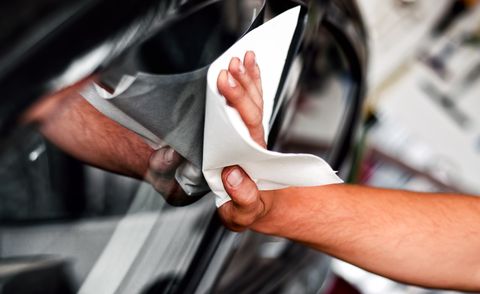So, the shine on your ride has died? What was a glossy finish has been beaten down to dullness by quickie carwashes, rough roads, and nasty weather? Even when it’s clean, it just doesn’t gleam like it once did? We denizens of the Midwest feel your pain.
You’ve tried to bring the finish back by polishing or waxing by hand, but you never quite complete the job before running out of time and energy. Of course, you could get your vehicle detailed by a pro who uses polishing machines and cleaning compounds. But that’s expensive. Besides, you like to do it yourself.
Take heart, gleam seeker. There is an affordable, lower-effort alternative for restoring your vehicle’s luster, one you can take on yourself. It’s called a dual-action polisher, otherwise known as a random-orbital buffer. Its two-way action creates a random pattern for quickly knocking out oxidation and eliminating swirl marks without harming paint. Your car will shine like a jewel in a crown.
Buffer prices range from around $100 to $250. Base your purchase on how many vehicles you’ll do per year. But know that even once-a-year beginners with lower-price buffers can get solid, pro-quality results.
First, of course, you need a high-quality buffer. (We’ve canvassed the detailing world and assembled four excellent machines at the end of this story.) But before you launch into power-polishing your ride, there’s some critical prep to do. The first act for achieving a new-car shine is a soap-and-water wash with plenty of fresh water and clean, soft towels.
Act II is a two-step decontamination, using a cleaner that removes bugs, tar, and other road goop, followed by a clay-bar rub to remove stains and contaminants embedded in the paint. (The clay bars come in kits with the appropriate cleaner-lubricant spray to provide great results.)
Act III is an up-close inspection to see what type of damage (light or deep scratches, swirl marks, buffing marks, acid-rain etching, or embedded contamination) has been sustained. The fussiest experts use a “swirl-finder light” ($40–$60) in a shady spot. This helps determine exactly what type of pad and polishing compound to use with the buffer. We generally skip this step, but we do recommend masking trim to protect it from the grit of compounds and polish.
There are several layers to a vehicle’s finish on the body panel: primer coat, color coat, and clear coat. Critically, you will be polishing only the final, outer layer (the clear coat) with the buffer, a pad with appropriate stiffness, and a polishing compound that’s so fine, you won’t be able to feel any grit in it. To keep you from burning through the paint and damaging the finish, orbital buffers have an internal mechanism that causes the polishing pad to slow to a stop if you bear down too hard. All you need do is apply five to seven pounds of pressure and let the machine do the work.
Professionals say to apply a small amount of the polishing compound to the polishing pad and smear it around a two-foot-by-two-foot area before you turn on the machine (to keep the compound from splattering). Then, using a crosshatched, overlapping buffing pattern, move the machine at about one inch per second. Make several passes before moving to the next section. The worse the surface damage, the stiffer the pad and the more aggressive the compound you’ll need. (Most pads are color coded and marked for their intended purpose.)
Vehicles with deeper swirl marks may require a more aggressive compound first, followed by an ultrafine compound. Start by using the buffer’s lower speeds, and finish with the higher speeds. You will use five to six pads on a small vehicle and seven to eight pads on a larger vehicle. (You can do the job with fewer pads, but having more on hand means you don’t have to wash them out as soon as they become caked with polishing compound.)
After you achieve a jewel-like surface, wipe the surface with a soft microfiber cloth to remove all traces of polish. The car is now ready for final paint protection. At this point, we just go with a good, old-fashioned carnauba liquid wax, but you might want to try a paint sealant or one of the new high-tech ceramic coatings. Enjoy the shine!


